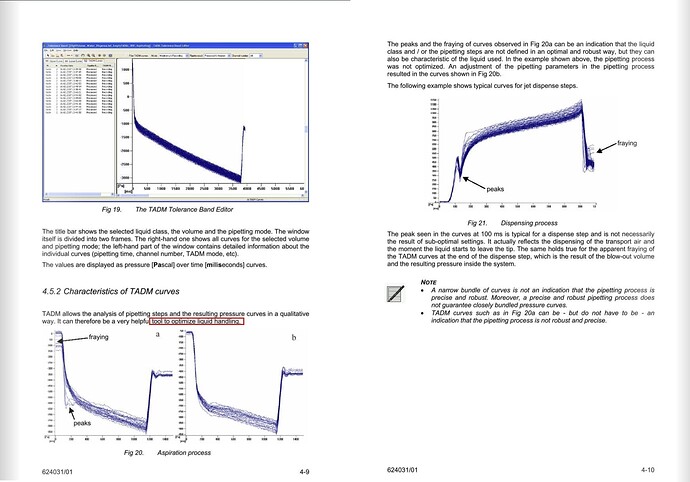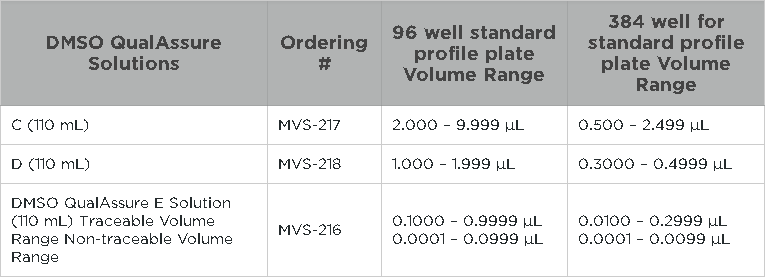Is it remotely possible to use Hamiltons TADM readings for liquid class calibration?
TADM could be useful for precision assessment of your liquid class and pipetting parameters and then tuning consistency of transfers. Mainly checking to see if you are having issues pulling air or liquid when you don’t expect it. I don’t think it would be at all helpful for accuracy tuning.
Hamilton has a tool called Dynamic Liquid Classification that uses TADM data to compare an unknown liquid transfer to a collection of known transfers. Unfortunately, as I understand it, there is a patent on this methodology that prevents us from selling it stateside.
There are good tips here to optimizing liquid classes in-run. In addition to this, here is my gravimetric method:
1.) Reach out to Hamilton to see if they already have a liquid class! If not…
2.) Start with a liquid class similar to the target liquid. Define what you want to do. Dispense jet empty, part volume? What kind of tips? What is the pipetting range?
3.) Perform all testing with the intended labware. Intended tips, reservoirs… To mimic a 96-well dispense plate I will often use 2D matrix racks loaded with 2D matrix tubes. These are easy to weigh and closely mimic most dispense plates.
4.) I’ll use two channels and perform 2-3 transfers at the high volume. I look for…
-Droplets. Do they form immediately when leaving the vessel? If yes, I’ll consider adding an air gap. If they form during transport to the dispense vessel and the liquid is volatile, I’ll consider using anti-droplet control.
-Accuracy. If close, I’ll move to the next step. If no, I’ll start by adjusting aspiration and dispense speed, and then move to other parameters.
5.) Still using two channels, perform 2-3 transfers at the medium and then low volume range. Again my focus is rough adjustment to eliminate unwanted behavior and dial in accuracy.
6.) Begin fine adjustment. Set up a program to dispense the volumes that will make up the calibration curve. E.g. using four 1000 uL channels with 1000 uL tips, dispense 50 uL twice. Loop 6 times, each loop add 190 uL to the transfer volume. 48+ gravimetric measurements will be monotonous. Keep in mind that while you have 8 replicates of each volume, there could be variation between pipetting channels. Once things appear dialed in…
7.) Liquid class validation. Run the fine adjustment but with a minimum of three transfers at each volume. Generate accuracy and precision data. If in a regulated environment, I suggest saving this data in a controlled form.
I find this takes ~2 hours to set up and perform for each tip and each dispense type. Subsequent liquid classes take ~1 hour. Some other suggestions:
-Liquid classes for the single-channel head often but not always translate to the 96-channel head with minimal modification.
-Using 2D matrix racks and tubes saves much time when gravimetrically weighing individual replicates.
-There are faster ways to optimizing liquid classes, but even in my lab where we use a wide variety of solvents I only perform liquid class development ~5 times per year.
-The Artel MVS is a great verification tool. Can be a bit costly. I think it is a must have when you have many systems. As a liquid class development tool though… I work with a lot of organic solvents that are not necessarily dye friendly. Just something to keep in mind if you consider purchasing one solely for liquid class development.
Hello, I wanted to know if anyone could recommend a good dye to use for testing liquid dispenses. My primary solvent is DMSO, so I need a dye for that, and in the future I will need a dye that will work with water as well. These plates would be analyzed using a Spectramax (or a similar plate reader).
Does anyone have any experience using DMSO with a plate reader? I know that most plate readers and their specialized plates are meant for use with aqueous solutions, so I’m anticipating that DMSO may cause problems. If you have any recommendations for how to address these issues I would appreciate it. Thank you!
Artel has DMSO specific QualAssure Solutions to go along with their more standard aqueous offerings.
I don’t have any technical details to build on what @EricSindelar_Hamilton already said, but when I’m advising folks on building liquid classes on the PREP, we always start with the closest existing liquid class and modify from there.
With the PREP it is running a different software/UI though, so you aren’t able to do a true “from scratch” liquid class, so take that with a grain of salt–I bring it up just to speak to the general philosophy we tend to use for this.
That is a great idea using Matrix or similar tubes (there are cheaper, non-barcoded versions) for weighing individual “wells” when working with multichannel pipettes.
A very simple approach:
We found that Eppendorf like 0.5 ml tubes fit very well into cavities of most 96 well plates to mimic a target cavity of the plate but to be weighed individually

